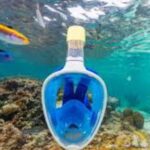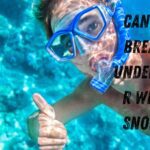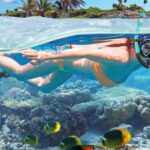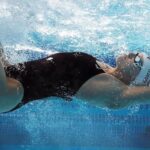Are Full Face Snorkel Masks Safe
Are full face snorkel masks safe? Well, let’s just say if your idea of snorkeling is “Face-hugged by a plastic dome while trying not to inhale seawater,” then yes… it’s worth asking before strapping one on like a budget Iron Man helmet.
But jokes aside, when you Google “are full face snorkel masks safe,” you’re not being dramatic — you’re being smart.
Safety underwater is non-negotiable. And whether you’re prepping for that once-in-a-lifetime Hawaiian vacation or just wondering if your Amazon purchase was a good idea, this question deserves an expert answer.
Let’s start with the truth.
Are Full Face Snorkel Masks Safe?
Are full face snorkel mask safe? Short answer: Yes, full face snorkel masks can be safe, but only if they’re high quality, properly fitted, and used under the right conditions.
Long answer: It depends on the design, the brand, your fitness level, and where you’re using it. The key issue? Carbon dioxide (CO₂) buildup. If a mask doesn’t properly ventilate exhaled air, CO₂ can collect, leading to dizziness, disorientation, or even blackouts. That’s not the kind of “sea-life encounter” anyone wants.
Several studies, including one from DAN (Divers Alert Network) found that poorly designed full face snorkel masks may allow exhaled air to accumulate, especially in knockoff brands or those lacking tested dual-chamber airflow systems.
But masks from reputable manufacturers are engineered to separate inhaled and exhaled air, minimizing risk.
So, if you’re buying the $15 off-brand “Snörkel FaceSpace 3000” from an unknown seller? Run. Not swim. Run.
Now that we’ve tackled the big question, let’s break down the real reasons this topic triggers so much curiosity — and how you can stay safe, informed, and relaxed during your next snorkeling adventure.
What Is a Full Face Snorkel Mask and How Does It Work?
A full face snorkel mask covers your entire face from forehead to chin and allows you to breathe naturally through both your nose and mouth. The snorkel is built into the top of the mask, often with a dry-top design to block water when submerged.
Internally, these masks are supposed to have separate airflow channels:
- Inhaled air comes through a chamber leading to your mouth and nose.
- Exhaled air is routed out through side vents.
The idea is awesome — no gagging mouthpieces, panoramic views, and effortless breathing.
But if the mask lacks this dual system or fits poorly, you could rebreathe carbon dioxide, which leads us to the next concern…
The CO₂ Buildup Controversy: Myth or Real Risk?
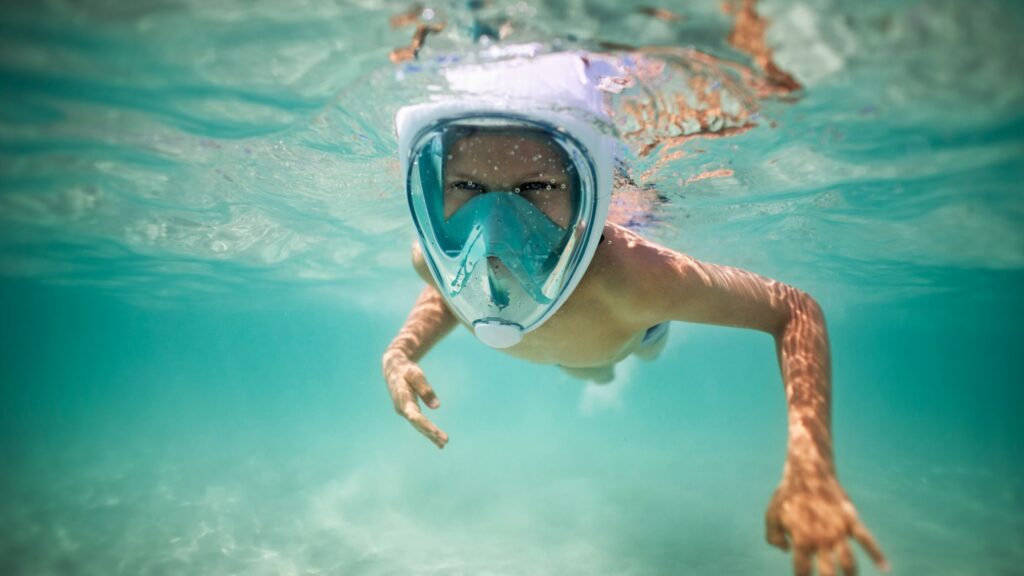
Here’s the core of the panic over full face snorkels. Can CO₂ collect inside the mask and cause accidents?
Yes — if the mask is poorly designed or too tight. In 2018, after several snorkeling deaths in Hawaii, local officials launched an investigation. While no direct cause was confirmed, CO₂ retention in poorly ventilated masks became a focal point.
According to the Hawaii State Health Department and DAN, most accidents involved masks without verified airflow separation.
Brands like Ocean Reef and Decathlon (makers of the original Subea Easybreath) stepped up and conducted internal and third-party testing, redesigning masks to ensure safe exhalation flow.
So, if you want full face snorkel mask safety, here’s rule #1:
- Buy from a known, tested brand.
- Avoid masks without documented safety testing.
Are Full Face Snorkel Masks Safe for Adults?
Yes, full face snorkel masks are generally safe for adults, as long as they are high-quality, properly fitted, and used under the right conditions.
Adults typically have stronger lung capacity and better control over their breathing than children, making them less prone to panic or CO₂ retention when using these masks.
Key adult safety tips
- Choose a reputable brand (like SEAC, Ocean Reef, or Decathlon’s Subea).
- Test the fit in shallow water before going out.
- Don’t use them for intense activity or free diving.
- Know your limits — if you feel short of breath, remove the mask immediately.
Also, avoid using full face masks in rough waters, or if you have asthma, heart conditions, or claustrophobia. Always snorkel with a buddy.
Are Full Face Snorkel Masks Safe for Kids?
Caution is advised. Full face snorkel masks are not recommended for young kids (especially under age 10) unless carefully supervised and using child-specific models from trusted brands.
Why the caution?
- Kids have smaller lungs, so CO₂ buildup can affect them faster.
- They may not recognize or verbalize discomfort (e.g., difficulty breathing).
- If they panic in the water, removing a full face mask takes longer than a traditional mask and snorkel.
Safer alternatives
- Use a traditional mask and snorkel combo with a dry-top snorkel.
- For older children (10+), you can use child-sized full face snorkel masks from reputable brands, but only under close adult supervision and in calm, shallow waters.
Traditional snorkel gear is still the safer, more controlled option for kids.
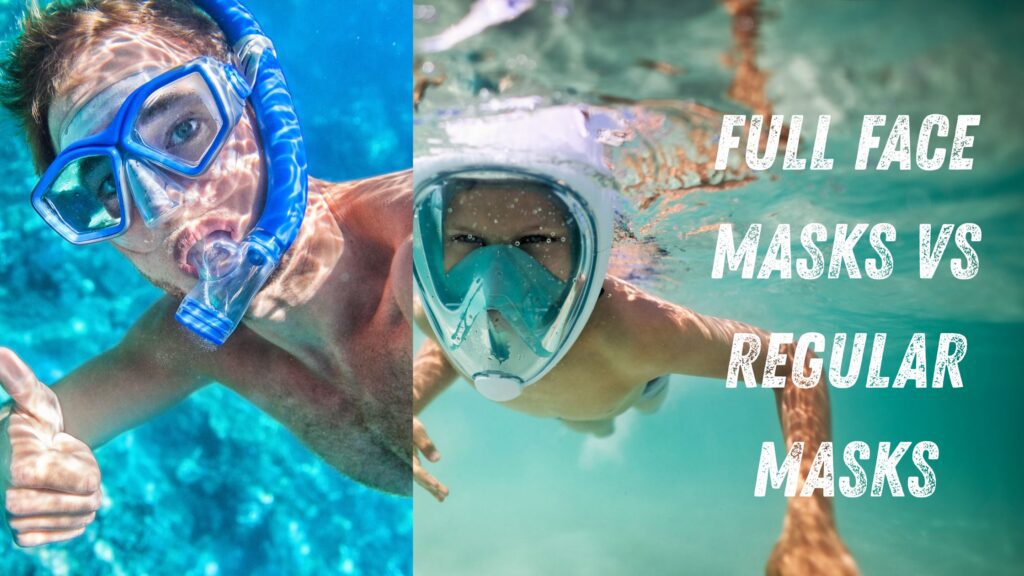
Full Face Snorkel Mask vs Regular Snorkel: Which Is Better?
| Feature | Full Face Snorkel Mask | Traditional Snorkel Mask |
| Breathing | Through nose & mouth | Mouth only |
| Comfort | No jaw fatigue, sealed face | Some jaw discomfort, open seal |
| Field of View | Panoramic 180° | Limited forward view |
| Suitability for Beginners | Very beginner-friendly | Slight learning curve |
| Deep Diving | Not recommended | Easier and safer to dive |
| CO₂ Risk | Higher if poorly designed | Low |
| Fogging | Less with good design | Can fog, but fixable |
| Safety in Rough Water | Not ideal | More control, easier to remove |
| Maintenance | Harder to clean | Easier to clean and dry |
Winner? If you’re a casual snorkeler who stays on the surface, a quality full face mask is comfortable and safe. But if you want to dive or need maximum control, stick with traditional.
In other words, don’t bring a full face mask to a free-diving fight.
Are Full Face Snorkel Masks Banned Anywhere?
Kind of. While no country has an outright national ban, some tour companies and snorkeling spots have restricted their use — particularly in Hawaii, Australia, and the Caribbean.
For example:
- Maui and Big Island snorkel tour companies may prohibit them.
- Some resorts only allow traditional masks or require lifeguard supervision for full face models.
These rules typically aren’t about the mask itself, but the risk it poses to inexperienced users who ignore safety guidance.
So always check local snorkel rules, especially if you’re renting or joining a guided group.
INTERESTING READ: Can you snorkel with glasses?
Do Cheap Masks Increase Risk?
Absolutely. Price often reflects engineering quality, especially when it comes to safety.
A cheap full face snorkel from a no-name seller may:
- Lack separated airflow chambers
- Be made of non-medical grade silicone (increasing leakage risk)
- Have fog-prone lenses or poor seals
- Include a snorkel top that fails in waves
That’s why snorkel mask reviews consistently show that the best full face snorkel mask models come from brands like:
- Ocean Reef Aria
- SEAC Libera
- Subea Easybreath 900
So, if your priority is full face snorkel mask safety, don’t cut corners. Your life > $20 savings.
How to Know If Your Full Face Mask Is Safe
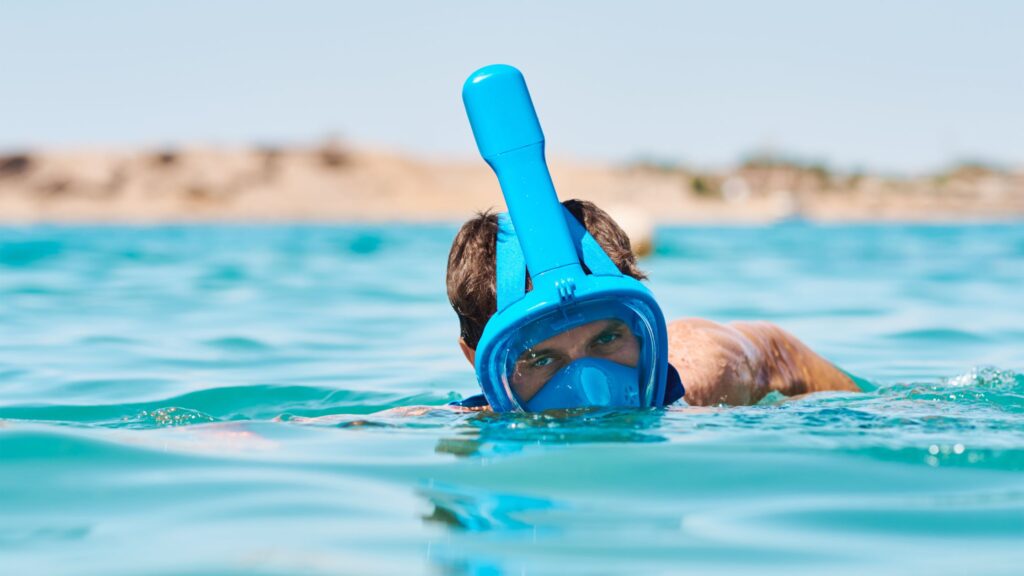
Here’s a quick safety checklist before using your mask:
✅ Dual airflow chambers (check specs or brand page)
✅ Anti-leak silicone seal
✅ Anti-fog lens system
✅ Wide, adjustable straps
✅ Dry-top snorkel valve
✅ User manual from a reputable company
✅ Fit test: Wear it in shallow water first and practice breathing
Want to know how to use snorkeling gear like a pro? Always test your mask in a pool or calm beach first before heading into deeper water.
What Happens If It Leaks or Fogs Up?
If your mask fogs, your vision is gone. If it leaks, your breathing could be compromised.
This is why the best full face snorkel mask options have:
- Fog-resistant coatings
- Separate airflow to prevent warm air from hitting the lens
- Adjustable silicone seals
If a leak occurs:
- Stay calm.
- Lift your head out of water.
- Remove the mask slowly.
- Dry and reseal.
Always practice what to do if your mask fails in shallow water before attempting open sea adventures.
Pro Tips to Stay Safe With Full Face Snorkel Masks
✔️ Only snorkel in calm, warm waters
✔️ Don’t use if you feel congested or sick
✔️ Stay close to shore
✔️ Use a snorkel buddy system
✔️ Wear a buoyancy vest
✔️ Know your limits — take breaks!
Snorkel Gear You Actually Need (According to Experts)
Thinking of what to pack for your next aquatic getaway? Here’s your essential list:
✔️ Snorkeling mask (or full face)
✔️ Dry snorkel (if using traditional mask)
✔️ Fins for propulsion
✔️ Rashguard or wetsuit
✔️ Snorkel vest
✔️ Anti-fog spray
✔️ Reef-safe sunscreen
✔️ Water shoes (if near reefs or rocky shores)
✔️ Waterproof gear bag
✔️ Know how much weight do you need for snorkeling if using any diving weights — most surface snorkelers don’t need any.
READ ALSO: Do You Need To Know Swimming For Snorkeling
The Bottom Line on Are Full Face Snorkel Masks Safe
So, are full face snorkel masks safe?
Yes, if used correctly and purchased from a trusted source.
Just like you wouldn’t ride a bike with broken brakes, don’t snorkel with a $12 death trap on your face. Your safety depends on the mask’s design, your understanding of how it works, and respecting your own comfort zone.
